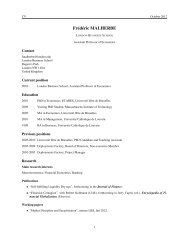101 Years of Investment Returns - London Business School
101 Years of Investment Returns - London Business School
101 Years of Investment Returns - London Business School
You also want an ePaper? Increase the reach of your titles
YUMPU automatically turns print PDFs into web optimized ePapers that Google loves.
4<br />
Millennium Book II: <strong>101</strong> <strong>Years</strong> <strong>of</strong> <strong>Investment</strong> <strong>Returns</strong><br />
historical record on interest rates and inflation. Chapter 7 presents the<br />
evidence on bond returns and bond maturity premia. We compare bond<br />
maturity premia across both different time periods and national markets. In<br />
these two chapters, we view the last <strong>101</strong> years through the lens <strong>of</strong> the financial<br />
markets. We see in the financial data all the turbulence <strong>of</strong> the past – inflation<br />
and hyperinflation, extreme periods when even bond and bill investors lost<br />
everything, deflation and the great depression, as well as two World Wars and<br />
their legacies.<br />
For the international investor, currency movements matter, since investment<br />
returns need to be converted from the local currencies <strong>of</strong> the countries in<br />
which the portfolio is invested into the investor’s own “home” reference<br />
currency. Exchange rate changes thus impact on performance, and are<br />
critical for measuring and comparing the returns from different countries. In<br />
Chapter 8, we report on the exchange rate fluctuations that were experienced<br />
by the fifteen Millennium Book countries over the course <strong>of</strong> the last <strong>101</strong> years.<br />
Chapter 8 also examines the extent to which has held over the long-run.<br />
Purchasing power parity implies that goods and services will have a similar<br />
price experience in different countries, but this is a poor description <strong>of</strong> yearto-year<br />
foreign exchange fluctuations. Over the long-run, however, we find<br />
that changing relative price levels do tend to be reflected in changes in<br />
exchange rates, and that real exchange rates are relatively stable. Chapter 8<br />
concludes by comparing the currency-adjusted returns on equities and bonds<br />
across our fifteen Millennium Book countries, and comparing these with the<br />
earlier rankings from Chapter 5 based on the real, inflation-adjusted returns<br />
within each country.<br />
In Chapter 9, we return to the equity markets to focus on two particular<br />
aspects <strong>of</strong> equity investment, namely the effects <strong>of</strong> size and seasonality. Over<br />
the last twenty years, the size effect, or the tendency for smaller companies to<br />
outperform larger ones, has become the best documented stock market<br />
anomaly around the world. In Chapter 9, we review the international<br />
evidence, including the UK record based on the ABN AMRO/LBS indices for<br />
the UK. A frustrating feature <strong>of</strong> the size effect is that, soon after its discovery,<br />
the size premium went into reverse, with smaller companies subsequently<br />
underperforming their larger counterparts. We show that this reversal was<br />
also a worldwide phenomenon.<br />
Chapter 9 also touches on stock market seasonality, providing a brief review<br />
<strong>of</strong> the various calendar-related anomalies that have been noted in the world’s<br />
stock markets. While a fuller analysis <strong>of</strong> these anomalies is beyond the scope<br />
<strong>of</strong> this book, we have singled out just one for closer attention, namely the<br />
January effect. There are two reasons for this. First, <strong>of</strong> all the calendar<br />
anomalies, the January effect is by far the most important, and is more<br />
famous than all the others. Second, it is closely intertwined with the size<br />
effect, since in the US, the entire historical outperformance <strong>of</strong> smaller stocks<br />
is attributable to their returns in January. Intriguingly, however, when we seek






